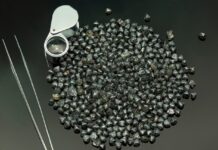The World Federation of Diamond Bourses (WFDB) has released the second in what is planned to be a regular series of blog articles by President Ernie Blom. Following the first blog that was distributed to the media last week on the issue of the Kimberley Process Certification Scheme, this blog looks at the New Normal in our trade relating to the critical issue of finance.
“A letter recently sent by ABN Amro Bank to its diamond industry clients stating that it would be limiting financing for rough purchases is the latest in a string of such decisions by the banking sector. The ABN Amro Bank decision is important in highlighting the need for the diamond industry to act prudently and buy only when profit can be made and to not borrow from the banks simply with the aim of holding on to their status with the rough suppliers or be used for other business,” said Blom.
The blogs are one of the measures decided upon at the last WFDB Executive Committee meeting in Israel aimed at expanding the WFDB’s global presence. One of the measures is to send out blog articles to the industry by a variety of means: via Social Media, directly to the bourses for distribution to their members, and to industry journalists for free use and publication, as well as on the WFDB site and a Newsletter link to each article. There will be a President’s Blog and an ExCo Blog.
Please find the blog below, which can be freely used with a credit line: By Ernie Blom, President, World Federation of Diamond Bourses.
A NEW NORMAL IN THE DIAMOND TRADE
By Ernie Blom, WFDB President
ABN Amro Bank recently sent a letter to several of its diamond clients stating that it would be limiting finance for rough purchases “in view of the continued lack of profitability in the purchase of rough goods. We recommend you to show constraint and only consider purchasing rough when there is sufficient profitability. We want our clients to … refrain from purchases just with the aim to hold on to existing allocations with the mining companies or just to remain fixed to sources only hoping for better times to come.”
From the office of the Secretariat of the World Federation of Diamond Bourses ● Pelikaanstraat 62, B-2018 Antwerp, Belgium ● T +32-3-2349121 ● F +32-3-2264073 ● E: secretariat@wfdb.com In other words, continuing to lend to businesses that cannot turn a profit is not what ABN Amro will do. What can one say about this? It is, of course, public knowledge that sightholders have been taking serious losses on every sight since January, and ABN Amro correctly questions how long this can continue.
The whole credit issue started some 15 years ago with the call from the international market for higher credit due to downstream integration. Since the DTC promoted supplier of choice policy, credit has literally exploded.
Antwerp Diamond Bank and Standard Chartered Bank have closed operations in the meantime. Bank of Baroda and Union Bank also withdrew from Antwerp. Liquidity became the scarcest commodity in the trade. Rumors have it that ABN Amro wants to seriously reduce further its portfolio – after it closed its US and UAE branches. This could be a potential disaster for Antwerp. All will now depend on how Indian banks will support the global trade and that is where the problem arose last year.
Banks have become extremely cautious with regard to diamond financing after Nirav Modi and his uncle Mehul Choksi, Chairman of the Gitanjali Group, were allegedly implicated in a USD$2 billion fraud involving the use of fake guarantees from the Punjab National Bank.
In the wake of the alleged scam, a series of steps have been implemented in India. According to the latest reports from India, the government-owned State Bank of India, India’s largest lender, has severely tightened controls for borrowers in the local diamond and jewelry sector. Most banks lending to the Indian diamond industry have begun trying to reduce their exposure to diamond firms.
Companies acting fraudulently can hurt the diamond industry as a whole. At some point, the banks learned their lesson and decide to reduce risk by supplying less credit and demanding greater collateral and secured assets. This is what is already happening.
The end of financial backing altogether could be right around the corner. Other financial institutions have already looked at the string of negative outcomes and may conclude that the diamond industry is a high-risk sector and decide not to work with the sector at all. In Belgium, diamantaires even have issues opening a simple bank account.
An oversupply of financing and credit in the wrong hands has led to wrong decisions in the diamond industry. It is common knowledge that there are many companies that are overleveraged in the diamond trade. If they fall, they could take with them the many companies to whom they owe money. Banks might not only reduce financing to poorly- managed companies, but are eventually going to be cutting off prudently-managed companies as well.
It is clear that some issues will have to change. Transparency will have to improve. It is important that the entire diamond industry addresses this topic because what hurts one diamond center hurts them all.
Therefore, ABN-Amro’s message comes at the right time. It is the mid-stream’s responsibility to buy wisely. Manufacturers know that they don’t need some of the rough they are buying – be it by type of goods or quantity. The midstream should adjust their level of demand according to their own sales volume and prices and only buy it if there is a profit to be made.
We have seen the market already anticipating the message which was given. The Times of India said last week that a combination of factors has led to a nearly 50% decline in production by small diamond manufacturing units in India. The TOI estimates there are nearly 4,000 diamond polishing units in Surat, some 500 of which have not opened since the summer vacation ended last week.
It is the role of the banks to ensure that the companies to whom they lend know how to assess the value of rough diamonds and act according to market trends. Of course, an oversupply of financing should not lead to an undersupply either. ABN Amro has been in the diamond trade for over 100 years since the high days of Amsterdam as a diamond hub.
The market should, however, come to a new normal and buy only when profit can be made and refrain from borrowing from the banks simply with the aim of holding on to their status with the rough suppliers or be used for other business. Blaming just the suppliers is the wrong message. The ABN Amro letter is a wakeup call for the industry.
Disclaimer: This information has been collected through secondary research and TJM Media Pvt Ltd. is not responsible for any errors in the same.




























